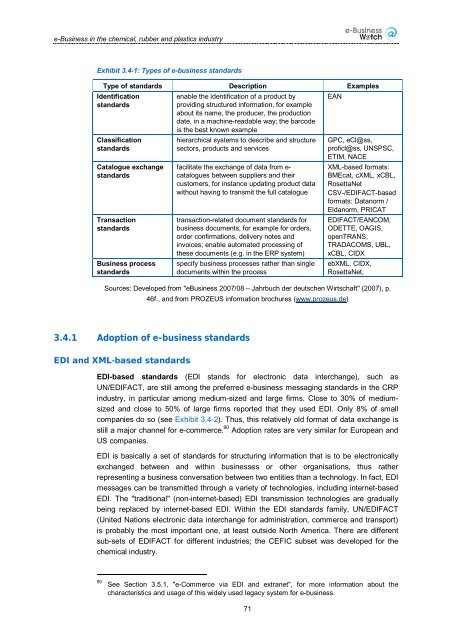Downloads - empirica
Downloads - empirica
Downloads - empirica
Create successful ePaper yourself
Turn your PDF publications into a flip-book with our unique Google optimized e-Paper software.
e-Business in the chemical, rubber and plastics industryExhibit 3.4-1: Types of e-business standardsType of standards Description ExamplesIdentificationstandardsClassificationstandardsCatalogue exchangestandardsTransactionstandardsBusiness processstandardsenable the identification of a product byproviding structured information, for exampleabout its name, the producer, the productiondate, in a machine-readable way; the barcodeis the best known examplehierarchical systems to describe and structuresectors, products and servicesfacilitate the exchange of data from e-catalogues between suppliers and theircustomers, for instance updating product datawithout having to transmit the full cataloguetransaction-related document standards forbusiness documents, for example for orders,order confirmations, delivery notes andinvoices; enable automated processing ofthese documents (e.g. in the ERP system)specify business processes rather than singledocuments within the processEANGPC, eCl@ss,proficl@ss, UNSPSC,ETIM, NACEXML-based formats:BMEcat, cXML, xCBL,RosettaNetCSV-/EDIFACT-basedformats: Datanorm /Eldanorm, PRICATEDIFACT/EANCOM,ODETTE, OAGIS,openTRANS,TRADACOMS, UBL,xCBL, CIDXebXML, CIDX,RosettaNet,Sources: Developed from "eBusiness 2007/08 – Jahrbuch der deutschen Wirtschaft" (2007), p.46f., and from PROZEUS information brochures (www.prozeus.de)3.4.1 Adoption of e-business standardsEDI and XML-based standardsEDI-based standards (EDI stands for electronic data interchange), such asUN/EDIFACT, are still among the preferred e-business messaging standards in the CRPindustry, in particular among medium-sized and large firms. Close to 30% of mediumsizedand close to 50% of large firms reported that they used EDI. Only 8% of smallcompanies do so (see Exhibit 3.4-2). Thus, this relatively old format of data exchange isstill a major channel for e-commerce. 90 Adoption rates are very similar for European andUS companies.EDI is basically a set of standards for structuring information that is to be electronicallyexchanged between and within businesses or other organisations, thus ratherrepresenting a business conversation between two entities than a technology. In fact, EDImessages can be transmitted through a variety of technologies, including internet-basedEDI. The "traditional" (non-internet-based) EDI transmission technologies are graduallybeing replaced by internet-based EDI. Within the EDI standards family, UN/EDIFACT(United Nations electronic data interchange for administration, commerce and transport)is probably the most important one, at least outside North America. There are differentsub-sets of EDIFACT for different industries; the CEFIC subset was developed for thechemical industry.90See Section 3.5.1, "e-Commerce via EDI and extranet", for more information about thecharacteristics and usage of this widely used legacy system for e-business.71
















